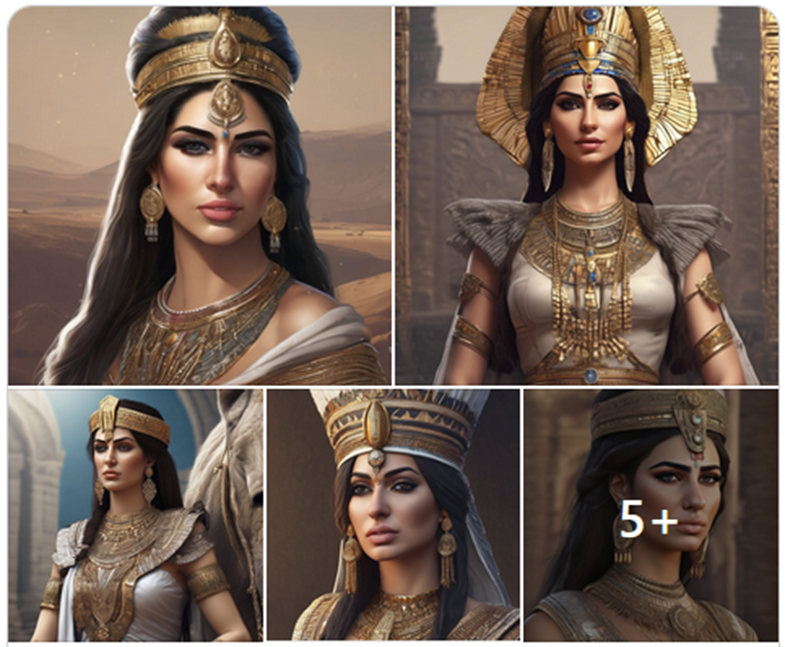Some names and origins of the queens of the Assyrian Empire

1- Queen Moliso-Mukaneshat-Ninoa:-
The wife of Ashurnasirpal II and the mother of his son, Shalmaneser III, before her marriage to Ashurnasirpal II, she was a Babylonian princess and the daughter of one of the kings of Babylon.
2- Queen Shamuramat or Semiramis:-
She is considered the greatest queen of Assyria and the wife of King Shamshi-Adad V and the mother of his successor Adad-nirari III. She is of Babylonian origin and has a Babylonian father and mother. Semiramis is considered the first Assyrian queen to fight military campaigns and she maintained her position even during the reign of her son.
3- Queen Hama:-
She is the wife of King Shalmaneser IV. She is a queen of Arab origin, as she was born and raised in the Kingdom of Lakhmad (currently Al-Hira) in southern Iraq. She appeared in one of the Assyrian inscriptions as the Princess of Arabs before her marriage to Shalmaneser IV. She is considered the youngest Assyrian queen, as she died at the age of twenty.
4- Queen Yaba:-
She is the wife of King Taghlib-pileser III and the mother of his two sons, Shalmaneser V and Sargon II, and she is of Palestinian origin.
5- Queen Panito:-
The wife of King Shalmaneser V, not much is known about her, and she is of Palestinian origin.
6- Queen Rima:-
The wife of King Sargon II and the mother of his successor, Sennacherib. She is of Babylonian-Arab origin. She was mentioned in the inscriptions of her son Sennacherib and in the name of the king’s mother. Scientists believe that she lived for a period after the killing of her husband, Sargon II.
7- Queen Atalia:-
She is also the wife of King Sargon II. She is a queen of Palestinian origin. She was the queen of Sargon. Scientists were able to identify her in the tomb of Nimrud. She was 30 years old when she died and is considered the second youngest Assyrian queen.
8- Queen Tashmitu-Sharat:-
Tashmitu Sharat is known mostly from Sennacherib's inscription praising her great beauty and with whom the king hoped to spend the rest of his life. She was clearly an influential figure in the Neo-Assyrian Empire. Tshmitu Sharat is known to have written her name on votive vases that were donated to temples. Although these inscriptions only record her name and position as Queen of Sennacherib, her mere presence is significant because very few people in Assyria were prominent enough to do such a thing and she was a queen of Assyrian origin.
9- Queen Zakoto:-
Wife of the Assyrian king Sennacherib and mother of his son and successor Esarhaddon, Zacuto is considered the best documented woman in the history of the Neo-Assyrian Empire, and she has reached an unprecedented level of fame and public visibility. She was perhaps the most influential woman in Assyrian history and a queen of Babylonian-Arab origin.
10- Queen Ishara-mother-in-law:-
The wife of King Esarhaddon and the mother of his successor Ashurbanipal, she was married to Esarhaddon before he became king. The known sources from the life of Ishara-Hamat that mention her are few, and thus she is known mainly from sources dating from after her death in February 672 BC, an event that influenced Strongly against Esarhaddon. Esarhaddon built a large mausoleum for her, which was unusual for the burial of Assyrian queens, and her death was recorded in Babylonian records. She is the mother of the most prominent of Esarhaddon's sons, i.e. the mother of his daughter Shiru-Tirat and the sons Ashurbanipal and Shamash-shum-ukin. She died at the age of 40. She died while pregnant, and her death was one of the reasons for the increase in Esarhaddon's disease. Esarhaddon did not choose a queen for him after her death, even when she was a queen of Babylonian origin.
11- Queen Libali Sharat:-
She is the wife of King Ashurbanipal, and they were married at a very young age. Some scholars suggest that her and Ashurbanipal’s age at the time of their marriage was 10 years. Lipali Sharat is considered the only queen mentioned in inscriptions before she became queen, even before her marriage to Ashurbanipal. She primarily hated Assyria and refused. He learned the Assyrian language, as a letter appeared from the daughter of Esarhaddon and the sister of Ashurbanipal, Siro Aitrat, scolding her for her refusal to learn the Assyrian language, as she was a queen of Babylonian origin.
Source: The Book of Queens of the Neo-Assyrian Empire

